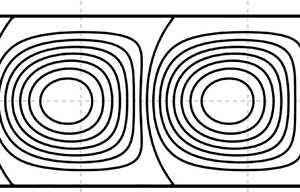Article contents
Rayleigh–Bénard instability in nanofluids: effect of gravity settling
Published online by Cambridge University Press: 26 October 2022
Abstract

Understanding the mechanism of thermal instability in nanofluids is of fundamental importance to explore the reasons behind the enhancement of heat transfer efficiency. Since Buongiorno (ASME J. Heat Transfer, vol. 128, 2006, pp. 240–250) proposed his theoretical model of nanofluids, most studies focusing on the thermal instability analysis exclusively considered Brownian motion and thermophoresis as the main diffusion mechanisms of nanoparticles. All the analyses concluded that a nanofluid layer is much more unstable than its pure counterpart as it is heated from below. However, a recent experimental observation on Rayleigh–Bénard convection appears to contradict the theoretical prediction, implying that some mechanisms neglected in the previous model may have a significant impact on the onset of thermal convection. In the present study, we revise the convective transport model of nanofluids proposed by Buongiorno and find that the gravitational settling of nanoparticles is a crucial factor influencing the thermal instability behaviour of nanofluids. By performing a linear stability analysis based on the novel model, the effect of gravity settling exhibits a stabilizing mechanism to resist the destabilizing effect of thermophoresis. Furthermore, the onset of instability can be delayed once the nanoparticle diameter exceeds a certain threshold, which explains the phenomenon observed in experiments. Particularly, the oscillatory mode is found to emerge and dominate the flow instability when the gravity settling effect is competitive with the effect of thermophoresis.
Information
- Type
- JFM Papers
- Information
- Copyright
- © The Author(s), 2022. Published by Cambridge University Press
References
- 8
- Cited by


